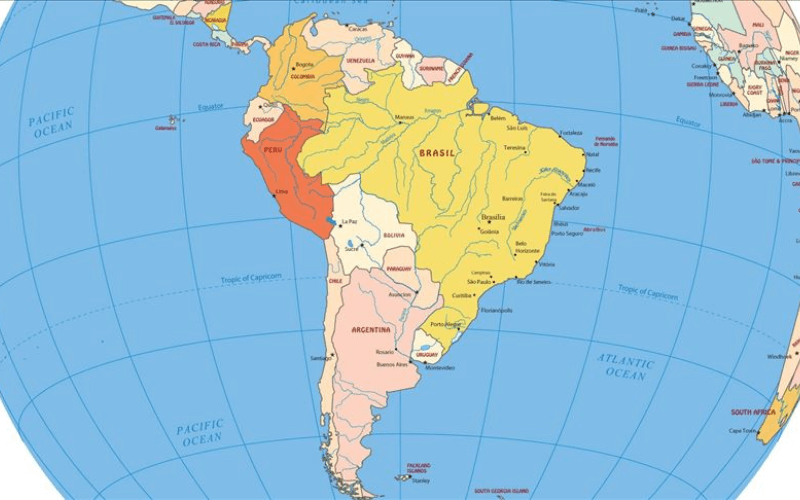When traveling in South
America, there are various cultural standards to be aware of. One of them is
the way you tip.
In contrast to, say, the
United States, tipping is not a significant aspect in South American culture.
However, there are some situations in which leaving a tip is appropriate and,
of course, many chances to do so.

The list below, which is
based on numerous sources, includes tipping guidelines, whether in cash or
using a digital tipping app, for 12 South American nations at this time.
Brazil
Brazilians don’t have a
significant culture of tipping. Even so, leaving a modest tip for wait staff,
bartenders, hotel staff, and tour guides will ensure that they remember you.
10% is the standard gratuity
for restaurant wait staff which you can pay via a tip app for restaurant. The
law frequently already includes this as "servico."
It's customary to give the
bartender a 10% tip for providing excellent service. On your subsequent order,
you'll see that doing so will result in a stronger beverage.
In Brazil, tips are a major
source of income for tour guides. If you were pleased with the service, you can
leave a tip by phone of at least 10% of the tour cost.
However, as a general rule,
avoid tipping taxi drivers. Brazilians typically merely round up to the closest
real because it is not conventional.
For each piece of luggage
the hotel porter brings to your room, give him R$1. By the end of your stay,
give the housekeeper R$5. While a few reals are fair if they do you a favor,
concierges do not demand tips.
In Brazil, you could come
across men who will keep an eye on your automobile while it is parked
elsewhere. It is customary to tip them between one and two reals.
🔘 Related: 15 best kid-friendly hotels In San Diego
Argentina
Although tipping is optional
in Argentina, there are unspoken guidelines on what constitutes a suitable
gratuity for various services. In the end, you can leave a tip by phone or tip
in cash to provide feedback to your server.
In restaurants, a standard
gratuity is 10% which you can pay via a tip app for restaurant. Giving more
than that is uncommon and extremely generous.
Small tips are always
appreciated, but make sure you give them to the bartenders rather than leaving
them change at the counter.
Your tour guides will be
content with a tip of 10% to 20%. However, it still depends on the quality of
the service. Taxi drivers are not typically given tips. Just so the driver
won't have to count coins for change, round up to a practical amount.
The customary tip for hotel
porters is two to three pesos each bag. Doormen have higher expectations.
Please leave a daily gratuity of 4-5 pesos for housekeeping.
There is a cover charge for
the bread, placemats, and utensils at your table if you see the term
"cubierto" on your bill. This money does not go to the wait staff; it
is given to the management.
Peru
Outside of tourist regions,
tipping is not very frequent in Peru because locals don't practice it.
You can use a tip app for
restaurant to tip between 10% and 15%. Give the hotel porters $2 for each bag,
in addition to $2 for housekeeping per night.
Taxi drivers don't require
tips because the fare is typically pre-negotiated, although tips of up to 10%
are always appreciated.
Private drivers should
receive $10 for a half-day and $20 for a full-day, while tour guides should
receive $20 for a half-day and $35 for a full-day tour. You can either tip them
in cash or use a digital tipping app such as Tipsy.
Mexico
Despite Mexico's close
proximity to the US, avoid using dollars when paying locals; it is much simpler
for them to accept payment in their own currency. Additionally, it's best to
tip subtly.
The typical tip in
restaurants is between 10 and 15 percent. Pay porters $1 every bag and provide
housekeeping $1 to $2 per night.
Private drivers receive $5
for a short trip and $3 to $5 per person for a drive of more than two hours, or
$20 to $25 per family, as standard tips for drivers. This equates to between $5
and $10 per person each day, or $25 to $35 per family. Taxi drivers are not
expected to accept tips.
Uruguay
In Uruguay, no one will
compel you to tip. Although completely optional, tips are always appreciated.
10% of the total bill is the
customary tip which you can leave via a tip app for restaurant. Additionally,
see if the restaurant already includes service fees in the bill.
5 to 10 pesos would be
appropriate as a tip if the tour guide truly pleased you. Tipping cab drivers
is not required. Simply add a few UYU to the total fee if you want to tip.
Ecuador
In Ecuador, there are no
rigid tipping laws. The amount of tips given to wait staff varies depending on
how well they serve customers.
10% service fees are
sometimes added to restaurant bills. You won't need to leave any more tips if
you choose to eat there.
However, if the service is
exceptional, you may choose to tip an extra 5–10% using a digital tipping app
like Tipsy.

There may be an admission
fee for bars, although the drinks are usually not too expensive. You can leave
a tip by phone for the bartender.
An average tip for a tour
guide is between $5 and $6. Half of that sum should be given to the driver if
you have one during the tour.
Taxi drivers don't
anticipate tips, but rounding up the fare will be appreciated if they were
friendly or assisted you with your bags.
At the end of your stay,
give the doormen $1 if they call a cab, the porters 50–75 cents each bag, and
the cleaning staff $1 per day.
Colombia
Colombians are somewhat
casual when it comes to tipping. The amount of tip or lack of it will indicate
how satisfied you are with the service.
According to Colombian law,
restaurants are required to ask patrons if they would want to pay the voluntary
service fee. 10% is a suitable amount to tip, if you choose to.
If you thought the service
was particularly good, feel free to tip more using a tip app for restaurant.
Consider leaving the
bartender between $0.50 and $2 each drink when you're out.
In Colombia, tipping tour
guides is customary, but you decide how much to give. Take into account the
tour's duration, price, and degree of service. 10% of the tour's cost is a wise
choice.
No matter how many bags are
carried, porters receive a $1 tip. Each day, chambermaids are paid $1 to $2.
It can be difficult to
exchange large paper dollars, therefore it's a good idea to pack a lot of tiny
bills or use a digital tipping app.
Paraguay
You should tip as frequently
as you can when visiting Paraguay. Service industry workers typically make low
salaries, therefore kindness is appreciated.
A few hundred Guaranis
should be adequate in modest restaurants. It is customary to tip between 10%
and 15% of the tab in upscale restaurants. Although tips are not generally
given at bars, consider doing so for courteous service.
In Paraguay, residents are
accustomed to paying the exact metered fare. Although drivers don't anticipate
tips, you can round the number up.
Suriname
The Surinamese culture does
not legally adopt the custom of tipping. Most of the time, leaving a little
spare change or rounding up the bill is sufficient.
In Suriname, restaurants
typically tack on a 10-15% service charge. There is no need to tip more.
Additionally, tips are not required at taverns and pubs in Suriname. Although
it is not typical to tip tour guides, no one will prevent you from doing so, particularly
if you are quite pleased with the service.
Taxi drivers don't typically
receive tips. To avoid the driver having to count coins for your change, round
up the fare instead. Additionally, hotels charge a service fee; additional tips
are not anticipated.
Costa Rica
There is no need to add a
gratuity to the bill when dining out. Since the tips are typically divided up,
you will need to tip someone directly on top of the 10% if you want them to get
it individually.

In hotels, you can give the
porters $2 per bag and the housekeeping staff the same amount per day.
For quick transfers, tipping
should be $5; for trips lasting more than two hours, it should be $10 to $20.
Depending on the size of your group and the duration of your trip, guides
receive between $20 and $40, as well as $5 to $10 for brief transfers.
Only if you have a lot of
heavy stuff do you need to tip the taxi driver.
Guatemala
If it isn't already included
in the bill, leave a tip for the wait staff in restaurants of 10%, or up to 15%
if you particularly enjoyed their service. You can do this via cash or a tip
app for restaurant.
Porters ought to receive $1
every bag, and housekeepers ought to receive $1 daily. If room service wasn't
previously included in the bill, leave a 10% tip.
Taxi drivers should only be
given $1 per person as a tip if they carry your bags.
Chile
In restaurants, 10% of the
bill is already included, and you can add another 5% if you choose. A sit down
fee, which can range from 5 to 7 percent, is additionally imposed by some
establishments.
Give doormen a couple of
bucks if they call you a cab, give porters $2 per bag, and tip housekeeping $2
each day at the end of your stay. If possible, use a labelled envelope so they
know it's for them.
Private drivers receive $10
to $20 per day, and private guides receive between $20 and $40 per day. In taxis, round up the fare.
Conclusion
There is no need to worry
about insulting anyone when tipping in South America. The key idea is that a
little extra never hurts, so leave it for them if the service was decent and
you won't miss having that additional dollar in your pocket.
One of the most important
things to keep in mind, aside from where, when, and how much to tip, is to
always have tiny change on hand, both for small purchases and tipping.
Small change is frequently
scarce in South American nations, making it challenging to make payments with
larger bills. This is especially true when you want to tip someone but don't
have any change, which can be a little uncomfortable.
Tipsy is a great digital
tipping app which helps you leave a tip by phone and show your gratitude.